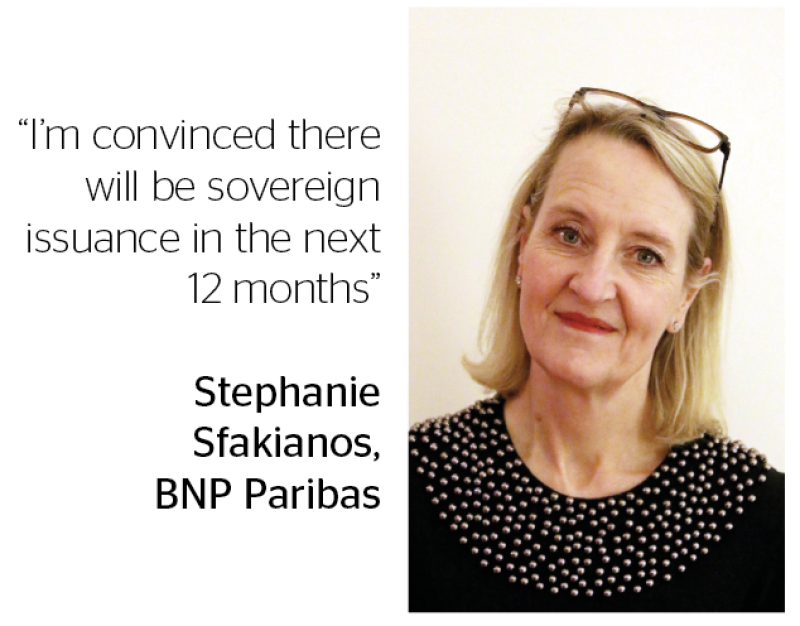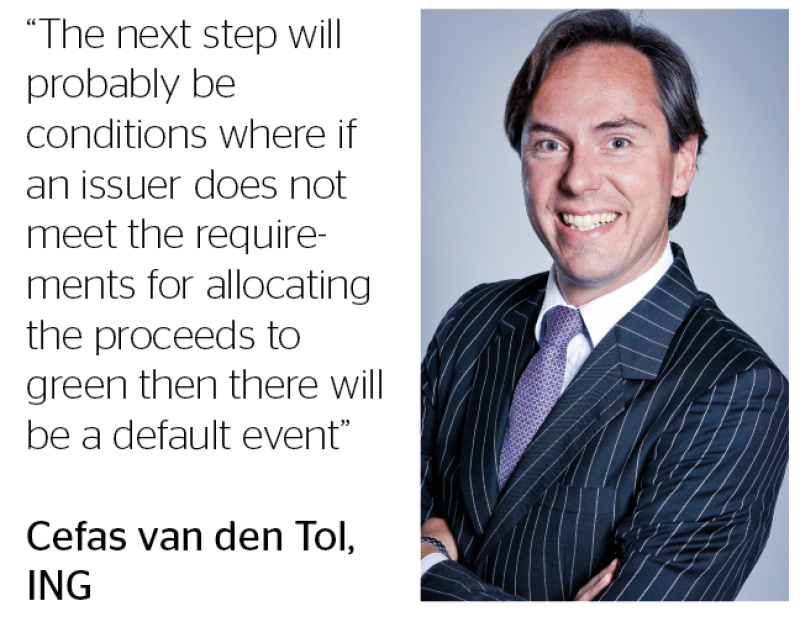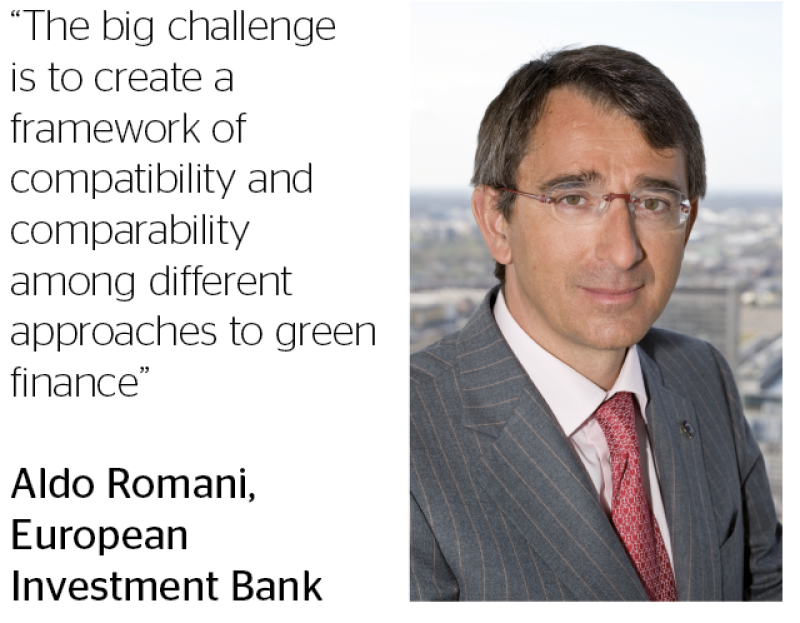The particularly large elephant that has yet to enter the green room is that of sovereign issuers. But that could soon change, with green bonds very much a
topic of conversation among the political classes.
“The G20 adopting green finance as one of its key themes for its September meeting shows that this is starting to be at the forefront of the political agenda,” says Ulrik Ross, global head of public sector and sustainable financing at HSBC in London. “There’s a realisation that a sovereign commitment to develop the market is needed. It’s all about them having the political agenda to enter the market. With the G20 meeting and COP22 in Morocco, there will be opportunities for sovereigns to show their leadership in embracing issuance into the green bond market.”
Many market participants believe the first sovereign green bond could be imminent.
“I’m convinced there will be sovereign issuance in the next 12 months,” says Stephanie Sfakianos, head of sustainable capital markets at BNP Paribas in London. “As part of the COP21 process, sovereigns made some very significant commitments and they are very well aware that this market needs supply and liquidity.
“There’s nobody better than them to provide very large liquid instruments. It’s probably going to be emerging market sovereigns to start with.”
Coincidentally, it is the very large sums that sovereigns need to raise that has partly hindered them in issuing green bonds so far, says Sfakianos.
“The main challenge for sovereign issuers is that they’re compelled to fund vast sums in a short space of time,” she says.
“One reason they haven’t issued green bonds is they can’t see a funding advantage. In the current market there are so many enormous challenges that it hasn’t been on their agenda. The big question for them is also on liquidity. The other big question is how they can be sure these bonds won’t just go to the normal investors.
“But some of these questions are being resolved. The requirement for sovereigns to support the growth of the green bond market is also becoming a driver in its own right.”
Investor evolution
In particular, the investor base for green bonds is developing and becoming more and more sophisticated in its approach — a welcome development for those issuers, like sovereigns, for which a strong placement with specifically green investors is a necessary prerequisite for joining the market.

This change is very much an evolutionary process, according to Christopher Flensborg, head of sustainable products and product development, fixed income and DCM at SEB in Stockholm.
“At first they dip their toe in, find out what it’s about but do so within their existing philosophy,” he says. “The second stage is, once they’ve seen it makes sense, they look to have a strategic approach. Some are moving faster than others due to the nature of the institutions or
the owners.
“The early green investors are going much deeper, with greater requirements. They’re trying to extract value from green bonds to create strategies. It’s expansion on all fronts, with very few exiting.”
For some investors, that deeper investigation requires more than just an adherence to the Green Bond Principles, a voluntary set of guidelines created by market participants to help clarify the features of a green bond.
“We have decided that our core green bond strategy would buy green bonds from companies that are already green to avoid greenwashing, as well as vanilla bonds from fully green
companies,” says Frédéric Samama, deputy global head of institutional and sovereign clients at Amundi
in Paris.
“We had spoken to issuers that are green and they asked why they should pay an extra cost to do green bonds when they are already green. We felt we’d been sending the wrong message, because we were helping some companies to greenwash and were penalising some that were already doing
the job.”

The pure play question
Amundi’s position of including vanilla bonds from fully green companies in its green bond strategy puts it slightly at odds with the latest edition of the Green Bond Principles, released in June, which for the first time tackled pure play bonds — those issued by organisations that are mainly or entirely involved in environmentally sustainable activities, but that do not follow the four core components of the GBP.
According to the Principles: “In such cases, investors will need to be informed accordingly and care should be taken to not imply GBP features by a Green Bond reference. These organisations are encouraged to adopt where possible the relevant best practice of the GBP (e.g. for reporting) for such existing environmental, climate or otherwise themed bonds, and to align future issues with the GBP.”
That stance is shared by other investors.
“We don’t believe it’s appropriate to say that every bond they issue is a green bond — for a bond to be labelled green, the issuer should comply with all parts of the Principles, including reporting and management of proceeds,” says Doris Kramer, head of investment strategies, sustainability at KfW in Frankfurt. KfW announced the introduction of a €1bn green bond investment portfolio in April 2015.
While the Principles inform issuers and investors in terms of how to label a bond green, investors are still doing the work themselves on what constitutes a green bond.
“We welcome the Green Bond Principles and the fact that we are moving more and more towards a label for green bonds,” says Marie-Anne Allier, head of euro aggregate fixed income at Amundi in Paris. “Before that, everybody was able to issue and just say, ‘It’s a green bond’ — and it would be recorded as such.
“Having said that, the strength of a big asset management house is to be able to label green bonds by itself and not rely on external rating agencies. The Principles are good news for the market because they create a common language between investor and issuer, but in itself — like a credit rating — it doesn’t prevent you from doing your own analysis. We already incorporated green in our SRI analyses.”
Working in harmony
For Aldo Romani, deputy head of funding, euros at the European Investment Bank in Luxembourg, one of the major features of the latest edition of the Principles is the establishment of a harmonised impact reporting framework for renewable energy and efficiency. That was based on work by a group of international financial institutions — including all the multilateral development banks and the bilateral development banks of France, Germany and Holland.

“Issuers have already started to refer officially to this framework — NRW.Bank, for instance, has done so in its sustainability report,” he says. “The challenge now is how financial institutions and corporates can best adapt that framework to their own needs.”
Some issuers are already forging ahead with this area.
“We report on a quarterly basis on our green bonds,” says Otto Weyhausen-Brinkmann, head of new issues at KfW in Frankfurt. “In this reporting investors find information about how much proceeds we received from the issuance of green bonds and for what type of projects these proceeds are used and in which region.
“In addition, we published our very first in depth impact report in April this year based on an independent research analysis of the underlying loan programme. This was a very detailed report on our first green bonds issued in 2014. The feedback we’ve received so far is that it’s exactly what investors are looking for as it’s focused specifically on the impact achieved.”
Harmonisation, not just in impact reporting, is key to the current and future versions of the Green Bond Principles, says EIB’s Romani.
“The latest edition of the Green Bond Principles has created conditions for a higher degree of comparability, specifically in the areas of reporting and external review,” he says. “There has been a structural improvement in terms of clarity.
“The GBPs are the only guidelines that source their authority in the market at large and they have proven that the system that has been put in place is able to produce consensus on the key issues of information production and dissemination among different categories of market participants. This creates a good platform for comparison and integrated analysis.”

The 2016 version of the Principles also attempts to enhance the comparability of external reviews via the establishment of a standard external review form, an area where EIB is looking to pioneer.
“In September 2016, [the EIB] was the first issuer to publish a Climate Awareness Bond statement that describes in detail EIB’s green bond practice (procedures, processes and reports) and is accompanied by an independent report with reasonable assurance issued by KPMG,” says Romani. “Attached to the report is the first external review form to be issued by an auditor following the model established by the 2016 GBP.”
The next step in this process of harmonisation will be for definitions, where there is “a lot of work still to be done”, according to Romani.
“The big challenge is to create a framework of compatibility and comparability among different approaches to green finance, to make sure that the content of green bonds is clear, univocal and comparable for impact investors, so that they can make choices that correspond to their individual preferences — which may and should be different — without uncertainty stemming from undue overlaps,” he says.
Legal language
For the moment, there is no legal requirement for issuers to ensure proceeds are used for green purposes. Some see that as a future area for development.

“The next step will probably be conditions where if an issuer does not meet the requirements for allocating the proceeds to green then there will be a default event,” says Cefas van den Tol, global head of corporate DCM at ING in Amsterdam. “At the moment it’s not hardwired that investors can enforce this. Reputation risk is a very good intermediate step. We’re in a fast growing market so these initiatives are in the interim.”
But KfW’s Kramer believes there is a balancing act between adding extra robustness to the market and adding extra volume.
“Some investors argue in favour of more legally binding documentation on the use of proceeds,” she says. “However, given that — for the time being — there is no price incentive for issuers to print green bonds, we believe the hurdle shouldn’t be set too high for the issuer. We have to balance between bringing new issuers to the market to build up a very diverse portfolio or setting the standards very high — thereby potentially limiting the number of issuers coming to the market.

“For the time being, having a more diversified portfolio is of greater value to us.”
The issue of self-policing in the market is also a matter of debate in terms of regulation. China is seen by most market participants as an exciting source of green bond volume, and in that country
there have been proposals to regulate the market while also offering certain advantages, such as tax incentives. But there is not a big appetite for a similar model elsewhere.
“We are afraid that if regulation is put on the green bond market, it could limit the number of issuers joining,” says Kramer. “It has been a very successful market initiative and we hope the market will have the space to develop further before regulators step in. It’s different in China, which has a completely different political and economic system. There it might make sense to have clear regulation, but it shouldn’t be a template for the worldwide market.
“If there were tax advantages for issuing green bonds then there might be an incentive for issuers to incur additional risk by having more legally binding documentation on the green side. But it’s too early for that.”
More supply
Whether or not other markets adopt the Chinese model, investors are certainly hungry to snap up bonds from the country — and other emerging markets.

“China has become one of the biggest issuers,” says Amundi’s Allier. “We are also looking for more issuance from India. Emerging markets will become a big segment of the market. Of green bond issuance in 2016, 45% has been from new issuers, which is good news. That also means that a large part has come from borrowers that have already issued, which shows that printing a green bond is not a one-off.”
On the other side of the supply and demand equation, developed market issuers are also keen to see a development among investors in emerging markets for buying green bonds.
“The interest in green bonds has increased a lot in emerging markets,” says KfW’s Weyhausen-Brinkmann. “From an issuer point of view, we’re also monitoring investor demand from emerging market countries. Even if the focus of these investors is not purely on top SSA credits we do look at them very closely.”
Other new sources of supply could come from developed markets, too. Since the UK voted to leave the European Union, there has been speculation that the country’s government will have a ‘fiscal reset’ aimed at boosting the economy through spending. With other governments now questioning the austerity model of the last few years, there could be room for green bond issuance to help plug the funding gap.

“The potential fiscal reset in the UK would be a big, big positive,” says BNP Paribas’ Sfakianos. “The point of green bonds is to support something in the real economy. It’s a stable policy framework that makes it possible for people to invest. For these projects to be introduced at scale is critical.
“Maybe not today, but not too far down the track, a sovereign will be able to think about the green projects it wants then we’ll have a virtuous circle of supporting green bond market growth and them getting more secure funding.”
Despite these new sources of supply, issuance is unlikely to reach the Climate Bond Initiative’s target of $100bn of annual volume in 2016.
“Reaching $75bn of issuance this year is a realistic target for the market,” says HSBC’s Ross. “We’ll likely see more out of China, which has been extremely strong so far. And probably a little bit from the FIG market, although it’s been a little slower this year than the last. Public sector issuance has been steady and there’s been bits and pieces of new corporate supply.
“I expect a continuation of diversification and for new issuers to embrace the market as the investor base appears to be developing at bullet speed. I wouldn’t be surprised if we see a sovereign come in 2016 or 2017, while there’ll also potentially be a development of some of the local currency markets.”
